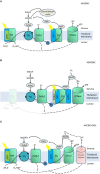Omics Application of Bio-Hydrogen Production Through Green Alga Chlamydomonas reinhardtii
- PMID: 31497598
- PMCID: PMC6712067
- DOI: 10.3389/fbioe.2019.00201
Omics Application of Bio-Hydrogen Production Through Green Alga Chlamydomonas reinhardtii
Abstract
This article summarizes the current knowledge regarding omics approaches, which include genomics, transcriptomics, proteomics and metabolomics, in the context of bio-hydrogen production in Chlamydomonas reinhardtii. In this paper, critical genes (HydA1, Hyd A2, Sulp, Tla1, Sta7, PFL1) involved in H2 metabolism were identified and analyzed for their function in H2 accumulation. Furthermore, the advantages of gene microarrays and RNA-seq were compared, as well as their applications in transcriptomic analysis of H2 production. Moreover, as a useful tool, proteomic analysis could identify different proteins that participate in H2 metabolism. This review provides fundamental theory and an experimental basis for H2 production, and further research effort is needed in this field.
Keywords: Chlamydomonas reinhardtii; genomics; hydrogen production; metabolomics; proteomics; transcriptomics.
Figures
Similar articles
-
Genomics of green algal hydrogen research.Photosynth Res. 2004;82(3):277-88. doi: 10.1007/s11120-004-2050-2. Photosynth Res. 2004. PMID: 16143840
-
Hydrogen photoproduction is attenuated by disruption of an isoamylase gene in Chlamydomonas reinhardtii.Plant Cell. 2004 Aug;16(8):2151-63. doi: 10.1105/tpc.104.021972. Epub 2004 Jul 21. Plant Cell. 2004. PMID: 15269330 Free PMC article.
-
New insights into Chlamydomonas reinhardtii hydrogen production processes by combined microarray/RNA-seq transcriptomics.Plant Biotechnol J. 2013 Aug;11(6):717-33. doi: 10.1111/pbi.12062. Epub 2013 Apr 3. Plant Biotechnol J. 2013. PMID: 23551401
-
Photosynthetic H2 metabolism in Chlamydomonas reinhardtii (unicellular green algae).Planta. 2007 Oct;226(5):1075-86. doi: 10.1007/s00425-007-0609-9. Epub 2007 Aug 25. Planta. 2007. PMID: 17721788 Review.
-
Hydrogen fuel production by transgenic microalgae.Adv Exp Med Biol. 2007;616:110-21. doi: 10.1007/978-0-387-75532-8_10. Adv Exp Med Biol. 2007. PMID: 18161495 Review.
Cited by
-
Hydrogen agronomy: research progress and prospects.J Zhejiang Univ Sci B. 2020 Nov.;21(11):841-855. doi: 10.1631/jzus.B2000386. J Zhejiang Univ Sci B. 2020. PMID: 33150769 Free PMC article. Review.
-
Transcriptome Profile Analysis of Arabidopsis Reveals the Drought Stress-Induced Long Non-coding RNAs Associated With Photosynthesis, Chlorophyll Synthesis, Fatty Acid Synthesis and Degradation.Front Plant Sci. 2021 May 25;12:643182. doi: 10.3389/fpls.2021.643182. eCollection 2021. Front Plant Sci. 2021. PMID: 34113361 Free PMC article.
-
Genetic engineering for biohydrogen production from microalgae.iScience. 2023 Jul 3;26(8):107255. doi: 10.1016/j.isci.2023.107255. eCollection 2023 Aug 18. iScience. 2023. PMID: 37520694 Free PMC article. Review.
-
Multiview learning for understanding functional multiomics.PLoS Comput Biol. 2020 Apr 2;16(4):e1007677. doi: 10.1371/journal.pcbi.1007677. eCollection 2020 Apr. PLoS Comput Biol. 2020. PMID: 32240163 Free PMC article. Review.
-
Debottlenecking the biological hydrogen production pathway of dark fermentation: insight into the impact of strain improvement.Microb Cell Fact. 2022 Aug 19;21(1):166. doi: 10.1186/s12934-022-01893-3. Microb Cell Fact. 2022. PMID: 35986320 Free PMC article. Review.
References
-
- Antal T. K., Krendeleva T. E., Laurinavichene T. V., Makarova V. V., Ghirardi M. L., Rubin A. B., et al. (2003). The dependence of algal H2 production on photosystem II and O2-consumption activity in sulfur-deprived Chlamydomonas reinhardtii cells. Biochim. Biophys. Acta. 1607, 153–160. 10.1016/j.bbabio.2003.09.008 - DOI - PubMed
-
- Boichenko V. A., Greenbaum E., Seibert M. (2004). Hydrogen production by photosynthetic microorganisms. Mol. Glob. Photosynt. 2, 397–451. 10.1142/9781860945496_0008 - DOI
Publication types
LinkOut - more resources
Full Text Sources



